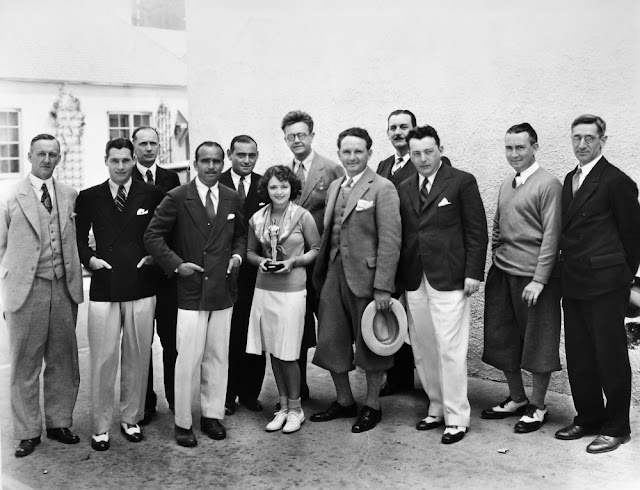On May 16, 1929 the first Academy Awards were presented at a banquet at the Hollywood Roosevelt Hotel. 270
people plunked down $5 for tickets
to the black tie event.
In many ways it was indistinguishable from award dinners common to any industry. The main
event seemed to be the dinner. The awards
were presented in a brisk 15 minutes after the deserts were cleared and after speeches
by founders of the Academy of Motion Picture Arts and
Sciences, including producer Louis B. Mayer who was a prime mover in establishing the
organization just two years before.
The Academy’s first President, actor Douglas Fairbanks, shared hosting and presenting
with his successor, director Cecil B. DeMille. There we no surprises. Award
recipients had been announced weeks
earlier.
While many things would change about
the annual ceremonies, one constant was the Award itself, a hefty gold statuette of a sleek man holding a sword point down with his hands clasp
in front of him. In 1931 Bette Davis would give it an enduring nick name by observing, “This
looks just like my uncle Oscar.”
The big commercial hit Wings starring Charles Buddy Rodgers, Clara Bow, and Gary Cooper walked away with one of two Best Picture Awards.
Recipients of the first awards were
mostly for films released in 1927. Many awards, including those for acting were given not for a single film, but for a body of work during the year. There were two best picture awards, Outstanding
Picture, Production for popular,
mainstream hits, and Outstanding
Picture, Unique and Artistic Production for what we would today call an art film. The action-packed World War I flying
adventure Wings starting Buddy
Rodgers, Gary Cooper, and Clara Bow won the commercial
award. Sunrise: A Song of Two
Humans, an allegorical film
by German director F.
W. Murnau staring George O’Brien as
The Husband and Janet Gaynor as The Wife
won the art award. The film included music and sound effects, but no dialog
on a sound track using Fox-Movietone Sound-on-Film system.
Janet Gaynor collected her statuette for two films. She would be a repeat winner in 1930.
It was a very good year for 22 year
old Gaynor. She won Best Actress in a
Leading Role for her performance as
the long suffering wife and for two films she made with director Frank
Borzage and leading man Charles Farrell, Seventh Heaven, and Street
Angel. Borzage took home the
trophy as Best Director, Dramatic Picture for the charming romance Seventh
Heaven.
That year
there was also a separate award for Best Director, Comedy Picture which
was won by Lewis Milestone for Two American Knights, produced by Howard Hughes and staring William Boyd—the future Hopalong Cassidy—and Mary Astor.
Best Actor in Leading Roll went to German character
actor Emil Jannings for work in two pictures, The Lost Command as an exiled Czarist
general, and The Way of All Flesh as
a businessman tempted and dishonored.
There were
three writing awards. The former
newspaper man Ben Hecht won Best Writing, Original Story for
the early gangster flick Underworld. Best Writing, Adapted Story went once
again to Seventh Heaven for Benjamin
Glazer’s screenplay. Joseph Farnham won in the doomed
category Best Writing, Title Cards for his whole body of work in
1927 which included Fair Co-Ed,
Laugh, Clown, Laugh, and Telling the World.
The day after the ceremony host Douglas Fairbanks and winner Janet Gaynor in less formal attire than the night before re-enacted the presentation for the press with director Frank Borzage in his golf knickers to Gaynor's left.
Awards were also given out for Best Cinematography (Sunrise), Best Engineering Effects (Wings), and Best Art Direction.
Two Honorary awards were given.
The first was to Charles Chaplain,
who had been withdrawn from
consideration in several categories of regular award because he did, well, everything. His citation read, “For versatility and
genius in acting, writing, directing and producing The Circus.” The
dawning of a new age was recognized in a special award to Warner Brothers “For producing The
Jazz Singer, the pioneer outstanding talking picture, which has
revolutionized the industry.”
When Sunrise: A Tale of Two Humans which was drenched in heavy German Expressionist symbolism was first released it mystified audiences and flopped at the box office. After winning the arty Best Picture category it was re-released and patrons flocked to movie houses to see what the fuss was about.
Even
the most optimistic boosters of the
new awards did not foresee how popular—and powerful—they would become. The eyes of Hollywood were opened when
winning films were re-released to
big audiences. Sunrise, in particular, which had made hardly any money in its
first release suddenly found an audience.
Thereafter the Awards—and the presentation showcases for them—would
become a very big deal indeed in Tinsel Town.





No comments:
Post a Comment